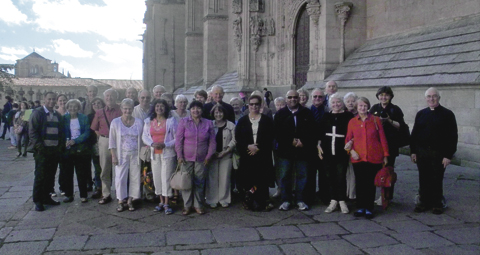October 31 | ![]() 0 COMMENTS
0 COMMENTS ![]() print
print

Spiritual refreshment, and great views, on Aberdeen pilgrimage
BISHOP HUGH GILBERT offers great insight into the Aberdeen Diocesan Pilgrimage to Fatima, Salamanca and Avila
IN 2012, Lourdes had been the destination of the Aberdeen Diocesan pilgrimage. In 2013 it was the turn of Rome. This year some 30 doughty pilgrims made their way to the Iberian Peninsula. They came from both the Inverness and Aberdeen ends of the diocese, and were accompanied on the October 11-18 journey by Deacon John Wire, the Chancellor of the Diocese, by the Vicar General Fr Stuart Chalmers, and by myself, Bishop Hugh Gilbert.
Our first port of call was Fatima. There, of course, our Lady appeared in 1917 to the three children, Jacinta and Francisco Martos and Lucia dos Santos. Our visit coincided with the anniversary of the final apparition on October 13. The event was marked by a concelebrated Mass presided over by the Archbishop of Goa. Though the temperature dropped and rain fell in unusual torrents, soaking clothes and shoes and threatening candles, spirits largely remained un-dampened. The austere holiness of the place and the local helpfulness were sensed by all. The Portugese Dominican Sisters were good hosts.
On Tuesday a four-hour coach journey took us through the hills of Portugal, over the Spanish border to the wide expanses of Castille and León. Our destination was Salamanca.
Salamanca is more than a resonant name. It is a city of outstanding beauty, home to one of Europe’s oldest universities, to an impressive Plaza Mayor, to many fine churches, and since 1988 to the historic Royal Scots College. Our hotel was located just across the old Roman Bridge across the River Tormes, and so with a 15-minute walk we could be in the gracious pedestrianised heart of this stately city.
St Teresa of Avila
As October 15 was the feast of St Teresa of Avila, and it was there we went first. Avila is only 108 kilometres from Salamanca, and a jewel in itself. There we were treated to a guided tour of the city, beginning outside its ancient walls and taking in many of the places associated with St Teresa, including her first foundation of reformed Carmel, St Joseph’s.
As we progressed round the city, crowds were gathering, occasional fireworks were released, and a great procession was beginning to form, complete with the military, musicians, clergy and religious and a flock of folk. St Teresa was born in Avila in 1515, 500 years ago next year. We were witnessing the opening of the Spanish Church’s commemorative Year of St Teresa. When we went on that same day to Alba de Tormes, the place of her death and yet another of her 17 foundations, we witnessed preparations for another such procession and open air Mass. It’s true to say that many of the pilgrims felt close to St Teresa in a new way and expressed a resolve to read her writings. She remains very much alive, and it is not hard to imagine her and her companions walking the narrow streets of the towns and travelling through the wide Spanish countryside.
Salamanca
The next day included a much-appreciated guided tour of Salamanca with a local guide and, as another high point, a visit to the Scots College.
The last act of the former rector, Fr Charles O’Farrell, was to give us a sketch of the College’s long history and a tour of its buildings. We also had the pleasure of meeting the new rector, Fr Thomas Kilbride. A Mass for vocations to the priesthood followed in the College chapel and an opportunity for confession.
On our last full day, the 17th, we were privileged to celebrate Mass in a side chapel of the great two-fold Cathedral, part 12th, part 16th century.
Indeed the heart of the whole pilgrimage was the daily Mass and the praying of Morning and Evening Prayer. Many of the pilgrims expressed their appreciation of this, and spoke of the ‘spiritual refreshment’ they gained. The common meals were times to renew old acquaintances or make new ones.
Fr Stuart’s informal evening tours of the city were enjoyed by all who shared them. There were precious moments of prayer in the churches we visited. Everything seemed to fall into place and, despite weather that could be distinctly northern first thing and very continental when the sun came out, all ran smoothly.
We were always adequately fed and comfortably housed. Pax Travel and a lot of hard backroom work by Deacon John Wire helped deliver the goods, as it were. Above all, our sense of the Church, past and present, was deepened, and the Lord felt to be in our midst.
It was a contented, grateful group that flew home from Madrid to a windy Scottish autumn.










